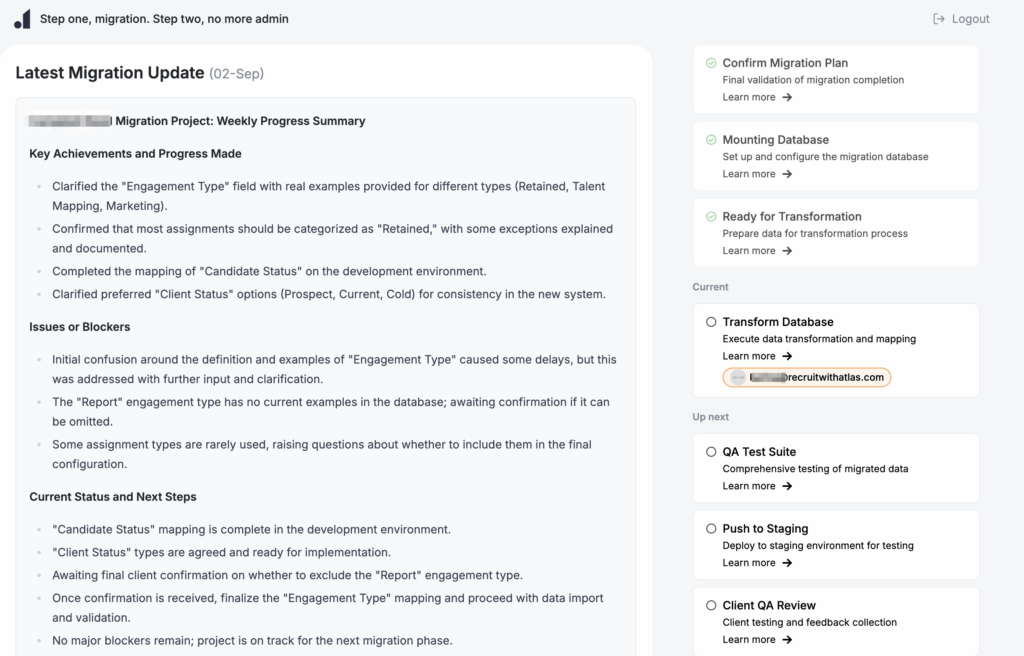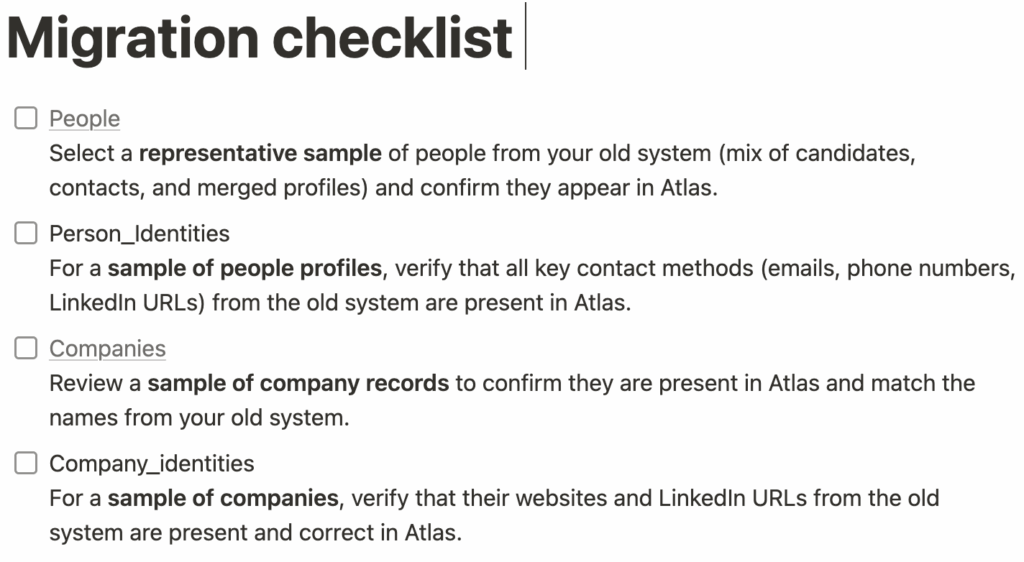
// Recruitment Technology
ATS Migration: 12 Costly Mistakes Recruitment Agencies Still Make (and the Fixes)
19/08/2025
12 MIN
Switching to a new applicant tracking system (ATS) is a major move for any agency midway through multiple recruitment processes. Whether you’re aiming to cut back on admin, modernise your workflows, or adopt a more AI-friendly system, a well-chosen ATS can unlock real gains. But without careful planning, a migration can easily create more problems than it solves.
We’ve seen it happen in the data migration process. Lost data, broken workflows, frustrated consultants and confused candidates are just some of the issues that crop up when agencies rush the process or skip key steps. For recruiters under pressure to deliver from every hiring process, even small errors can lead to costly delays and reputational risk.
In this guide, we unpack 12 of the most common migration mistakes that agencies still make, along with the fixes that will help you avoid them. Drawing on our experience managing migrations from other platforms to Atlas, we’ll also share how our three-phase process—Plan, Execute, Verify—helps recruitment teams migrate with confidence.
Use this article as your roadmap for a successful data migration to a future-proof ATS.
Pre-data migration pitfalls
1. Lack of a clear migration strategy
One of the most common missteps is migrating data without a defined strategy. Agencies often underestimate the complexity involved in migration tools and jump straight into transferring data or configuring their new system without first setting clear goals.
A proper ATS data migration plan should cover timelines, team responsibilities, risk mitigation, data scope, and business priorities. Without this structure, decisions tend to get made on the fly, which increases the likelihood of delays, misaligned workflows, or data gaps.
At Atlas, we use a three-phase framework—Plan, Execute, Verify—that gives agencies a structured approach from day one. In the planning stage, we help agencies clarify what success looks like for them and map out exactly how to get there.
2. Underestimating data integrity in auditing
If your data is messy going in, it will be messy coming out. Many agencies assume that everything in their current system is worth keeping, but this often isn’t the case.
Outdated candidates, duplicate records, missing client information—these issues can carry over and create noise in the new system, leading to corrupted data from day one. Auditing your data before the move helps prevent this. That means reviewing and cleaning up your database, applying filters for GDPR compliance, and deciding what to archive versus what to migrate.
A proper audit ensures your new ATS starts fresh, not burdened by years of clutter.
3. Failing to involve stakeholders early
Leaving migration decisions to a small internal team—or worse, just IT—is another common mistake. The people who actually use the ATS every day, like consultants and compliance staff, often get left out of key decisions. This can lead to frustration, poor adoption, and workflows that don’t match how the agency actually operates.
Involving the right people early makes all the difference. It surfaces potential issues before they become blockers and gives your team a sense of ownership in the process.
Real-world result: Ocean Red Partners reduced a typical six-week migration down to just one or two weeks by following a structured migration plan and involving key stakeholders from the beginning. Post-migration, they saw an 85% increase in monthly billing—a direct outcome of streamlined workflows and better consultant adoption.
Technical data migration challenges
4. Poor data mapping with the current ATS vendor
One of the most technically complex processes of ATS migration is data mapping. Agencies often assume their fields and all sensitive data will transfer cleanly from one system to another, but field types, structures, and naming conventions often differ between platforms.
Without careful mapping, information can land in the wrong place—or disappear entirely, compromising your future system performance. For example, candidate notes might end up as unreadable attachments, or phone numbers might all funnel into a single field with no label for type.
To prevent this, you can work with Atlas to document exactly how each field should be mapped. At Atlas, we walk agencies through detailed mapping workshops that align not just fields, but also tags, custom values, and relational data across entities like candidates, clients, and jobs.
5. Skipping data normalisation leads to data loss
Even when fields are mapped correctly, inconsistent formatting within your existing data can cause problems. Dates may appear in multiple formats, job titles might vary in spelling or structure, and location fields can contain mixed data (e.g. “London, UK” vs. “London”).
Skipping the normalisation step creates a cluttered experience in the new ATS and can affect reporting, filtering, and automation rules.
Before migrating, standardise your data as much as possible. This includes applying consistent formats, cleaning up category values, and removing legacy codes that no longer serve a purpose. We recommend reviewing your data in bulk and applying transformation rules before import to ensure accuracy and usability in the new system.
6. Overlooking GDPR compliance
Migrating outdated or non-compliant data can open your agency up to serious legal and reputational risks. This is particularly important for UK-based recruiters operating under GDPR.
Many legacy systems are full of expired candidate records, missing consent, or outdated communication preferences. Transferring that data to a new platform without review can violate data protection policies.
During the audit and mapping phases, ensure you apply filters based on consent status, retention periods, and communication history. It’s also wise to document your compliance approach so you can demonstrate due diligence if needed. We help agencies automate this filtering process so only compliant, current data is brought into your new ATS.
Operational gaps when switching from your current system
7. Not testing the new applicant tracking system properly
One of the most avoidable causes of migration failure is a lack of testing. Many agencies skip or rush the testing phase, assuming the new system will “just work.” But without proper validation, it’s easy to miss misaligned workflows, broken data links, or permission errors.
Testing should involve more than a technical check. Consultants need to trial key workflows—like adding candidates, sending CVs, and logging calls—to ensure everything performs as expected. This step surfaces issues while there’s still time to fix them, before going live.
We always recommend running a test migration before the final move. This creates a sandbox where recruiters can get hands-on and confirm that the system fits their day-to-day reality. It also allows us to make adjustments to often complex data structures before anything goes live.
8. Inadequate ATS software training for consultants
No matter how powerful your new ATS is, it won’t deliver value with inadequate training. Agencies often underestimate the learning curve involved, assuming the new system is intuitive or similar enough to the old one.
But every ATS provider and their system is different. Without structured, proper training during onboarding, even experienced recruiters can feel lost or revert to old habits—like falling back to spreadsheets or ignoring key features, leading to potential human error.
Training should be tailored to different user roles. A rookie consultant has different needs than a billing manager or compliance lead. At Atlas, we give you continuous learning powered by our team and a rich knowledge base, as well as ongoing support to make sure your consultants feel confident, not overwhelmed by a more advanced ATS.
9. Lack of contingency planning
Even the best-laid plans for migrating data can go sideways. If there’s a delay, data integrity issue, or unforeseen outage, agencies without a fallback plan are left scrambling to handle complex data structures.
One of the most common mistakes is decommissioning the old ATS along with your historical data immediately after migration. This removes your safety net too soon and makes it harder to roll back if issues arise.
We always recommend keeping access to the legacy system during and shortly after the migration to ensure a seamless recruitment process. A parallel run approach, where both systems are live for a brief period, gives your team time to validate data and processes with minimal risk, leading to a smooth transition. Planning for the unexpected and using both old and new systems at the start will ensure that your migration doesn’t become a crisis when something small goes wrong.
Potential post-migration bottlenecks
10. Ignoring candidate experience workflow customisation
Once the migration is complete, many agencies stick with the out-of-the-box workflows that come with their new ATS. While that might seem like a shortcut, it often leads to uneven candidate data quality.
Every agency has its own recruitment needs and ways to source qualified candidates. If the system doesn’t reflect that, consultants are forced to bend their process to fit the software instead of the other way around. That slows people down, leads to workarounds, mounting manual tasks, and reduces adoption.
The best time to customise your workflows is immediately after the initial migration. Rebuild key processes—like candidate qualification, client onboarding, or interview scheduling—to match how your team actually works. This will enhance efficiency and significantly streamline your operations from day one.
11. Failure to communicate with clients and candidates
ATS migrations are internal projects, but they often affect external stakeholders too. If consultants are working in a new system, client and candidate communication may shift—especially in the early days.
Failing to communicate these changes can lead to confusion. Candidates might receive unexpected emails or experience delays, and clients may notice differences in reporting or communication style.
A simple, proactive comms plan can prevent this. Let clients know that you’re upgrading your systems to improve service. Tell candidates what to expect. This doesn’t need to be complex—just clear, timely, and transparent.
12. Not measuring for continuous improvement
Once a migration is done, it’s tempting to move straight on with business as usual. But without reviewing how the project performed, you risk missing signs that something didn’t land well—or that further optimisation is needed.
Set measurable success criteria from the start. This might include adoption rates, workflow speed, system uptime, or time-to-fill. Track them at regular intervals—30, 60, and 90 days post-launch—to gauge progress and identify areas for refinement.
Proof it pays off: Executive Integrity tracked key performance metrics after their migration and saw a 34% improvement in fill rate, along with a 28% increase in average billing per consultant. By taking post-migration measurement seriously, they were able to unlock the full value of their new ATS and drive performance across the board.
Avoiding common ATS migration mistakes: 5 steps to get it right
Step 1: Don’t skip the data review
One of the biggest mistakes teams make during an ATS migration is jumping into the process without fully understanding what their current data looks like. Whether you’re moving from a legacy platform or a modern CRM, it’s critical to review your export before doing anything else.
Look at what’s actually in the files: Are key fields populated? Are there duplicate records or old statuses that no longer make sense? Taking the time to assess your data upfront will save you major cleanup work later.

Step 2: Map fields carefully before transforming anything
Field mapping is not a checkbox exercise. Rushing this part of the process often leads to broken workflows, missing information, or inconsistent record structures in the new system.
Take the time to compare your current field labels with the new platform’s data model. Align fields thoughtfully, especially if you have custom tags, statuses, or workflow stages. Make sure everyone involved understands what each field actually represents.

Step 3: Don’t rely solely on manual QA
Manual reviews have their place, but they aren’t enough to catch deeper issues in large datasets. Overlooking automated QA during migration increases the risk of letting through duplicate records, mismatched formats, or empty critical fields.
Use automated testing to check for required fields, data integrity, and consistency across tables. You should also incorporate anomaly detection to identify strange or unlikely data patterns.

Step 4: Validate in staging, not production
Skipping a staging environment is a fast track to frustration. You need a place to safely inspect and interact with your migrated data before it goes live.
Use a staging version of your new ATS to validate that all data appears where and how it should. Review candidate records, job details, files, and relationships. Run searches, apply filters, and explore workflows just like your users will. Confirm it works before signing off.

Step 5: Don’t treat it like a one-time task
Migration isn’t finished once the data lands in the new system. You’ll need to support your team during the rollout, provide visibility into changes, and potentially handle follow-up cleanups.
Build a feedback loop. Track comments, spot any gaps, and make post-migration improvements if needed. The best migrations are treated as part of a broader change management process, not just a data dump.
Frequently asked questions (FAQs) on ATS migration mistakes
It depends on the size and complexity of your database. A typical migration can take anywhere from two to six weeks. That said, with clear planning and clean data, we’ve helped agencies complete full migrations in just one or two weeks. The more time you invest in pre-migration prep, the faster the actual switchover tends to be.
Yes, and in many cases, that’s the smarter option. Migrating every record you’ve ever stored can slow down the project and clutter your new system. Instead, we recommend focusing on active candidates, current clients, and recent placements. Legacy data can be archived or made accessible separately if needed.
Early involvement and good training are key to circumventing potential challenges. When consultants feel included in the planning process and understand how the new ATS will make their day easier, adoption improves. We also find that role-specific onboarding and hands-on support in the first few weeks go a long way toward reducing friction.
Yes, at least temporarily. Keeping access to your old system during and shortly after migration gives your team a fallback if anything goes wrong. It also allows for side-by-side validation, which helps build trust in the new platform. Once you’re confident everything is running smoothly, you can fully decommission the legacy system.
Not if the migration is planned and executed properly. We typically recommend running migrations over weekends or during low-traffic periods. With the right preparation—including test migrations and parallel access to your legacy system—your consultants should be able to keep working without interruption.
Migrate to an applicant tracking system (ATS) that drives your pipeline forward
A successful ATS migration isn’t just about moving data from one system to another. It’s about setting your agency up to work smarter, move faster, and deliver a better experience for both recruiters and clients with valuable insights and a reliable application process. And that doesn’t happen by luck—it takes planning, the right tools, and a partner who knows what good looks like.
At Atlas, we’ve already supported countless agencies through complex migrations, and we’ve seen firsthand what separates success from struggle. Our structured process—Plan, Execute, Verify—helps recruitment teams avoid costly mistakes and start strong on their new platform.
But Atlas isn’t just an ATS. It’s an all-in-one recruiter hub powered by automation and agentic AI, built to eliminate the admin that slows consultants down. From candidate sourcing and shortlisting to client comms and reporting, Atlas helps agencies scale without the busywork.
If you’re planning a migration and looking for a seamless transition, or just want to see what a truly modern recruitment system looks like, we’d love to show you how it works.







